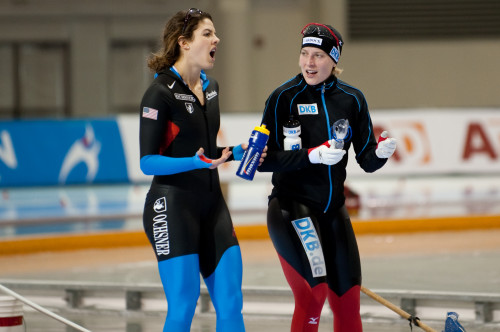Speed Skating Daily: Ladies’ 3000m
There were a few surprises in yesterday’s men’s 5000m. Sven Kramer won in olympic record time, as predicted, but the other podium places were less predictable. Lee Seung-Hoon of Korea took an unlikely silver medal ahead of Ivan Skobrev of Russia who, in turn, beat out Norwegian Håvard Bøkko. Bob de Jong, paired with Lee, didn’t seem to get into a good rhythm and was not able to make the podium, while defending champion Chad Hedrick also fell by the wayside. Bøkko and Hedrick were in the final pair, and in their final laps, Skobrev waited anxiously to see if one of them would deprive him of a bronze medal. In the end he managed to hold on to third place by less than a second.
As for the ladies 3000m later today, we should expect surprises of a similar nature.1 The “prohibitive favorite” (as has become a common term in the TV coverage here) is Czech skater Martina Sablikova – watch her step corner-crossovers until almost a third of the way down the straight, but she is not invincible. Stephanie Beckert of Germany has beaten her a few times earlier this year and presents a significant threat. I would say that she would be more of a threat if she were paired with Sablikova, but she is in a later pair, with Kristina Groves of Canada – a medal contender, but for the bronze.
Defending champion, Ireen Wüst of the Netherlands and Beckert’s team mate Daniela Anschutz-Thoms are also threatening for the medals. Flag-bearer for Canada Clara Hughes, Japan’s Masako Hozumi, Norway’s Maren Haugli, and Americans Rookard and Swider-Peltz Jr. are also outside medal chances.
A note about the ice: it isn’t great. There have been many complaints in the practice days preceding the games and I skated on it several months ago. When I skated on it, the ice was too soft. Now they’ve gone the other way and made it quite hard, but it also brittle and has a tendency to break off. In the distance races, you’ll notice skaters increasing their cadence and taking shorter, quicker steps, especially on the corners because of this. In addition, the added heat and humidity of filling the stadium with people is causing the ice condition to degrade more quickly than normal. This means that the advantages of being in a later pair (this only really applies to the long distance events) are outweighed by being in an earlier pair. In the 3k and 5k, the ice is resurfaced after the 7th pair. I’m predicting more spills than usual, especially in the sprints, in the later pairs.
- although, if we expect it, then it is really a surprise? ↩



Leave a comment